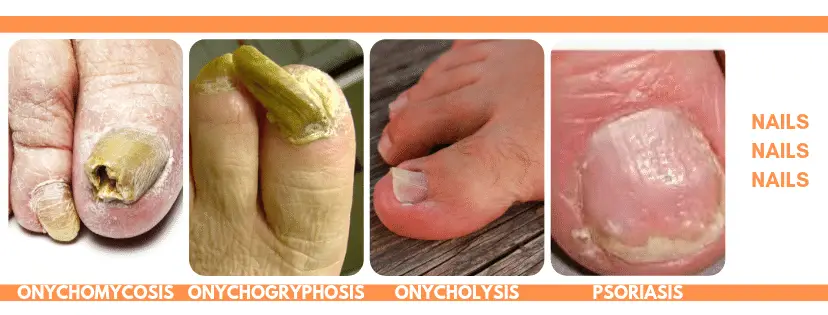Look away if you’re squeamish – we’re talking fungal nails
After over 10 years in podiatry, one of the most common questions I get asked is “what do you think of this toenail? Is this fungal?” Yes, this question is usually asked clinically but there’s still plenty of people who, as soon as they find out you’re a podiatrist, cannot wait to kick off their shoes and poke their toenail in your face.
After a lot of time and experience and answering aunties’ questions at family BBQ’s, I thought I would write up a guide.
Fungal Toenails
How do I know if it is fungal?
Do you know the purpose of toenails?
No, they aren’t just there to be painted pretty colours! Toenails are a throwback to when we climbed trees and needed the traction and grip as we scaled up like our chimp, bonobo and monkey brothers and sisters. Nowadays, they act as a protective layer and shield the tip of the toe from trauma. This means they are also subject to different forms of stress; they can rub against shoes, stubbed against bedposts, and can be in the constant presence of bacteria and fungi.
So is my funny looking nail a fungus, or a false alarm?
At times, it can be hard to tell if you have a fungal nail infection, nails affected by psoriasis or even just nail trauma, there are many nail conditions that appear similar, hence a lot of confusion!
Nail fungus or onychomycosis is among the most troublesome of nail conditions. There are many types of fungal infections. Toenails are typically affected more so than fingernails as they are often covered in closed shoes and socks, which traps moisture inside, allowing the fungus to grow and thrive. Some people are more prone to developing such infections, such as people with diabetes, poor circulation, advancing age and medical conditions causing a compromised immune system. As well as people with regular paint or cover up their nails, and use public pools or communal showers regularly.
There are two main types of fungal infections
Subungal Onychomycosis – the most common form of toenail fungal infection. The infection that discolours your nail and makes them crumble, yellow and thickened.
Superficial White Onychomycosis – this type only affects the top layer of the nail and appear as white makes on the nail. Often found after removing a thick layer of nail polish.
The general appearance of fungal toenails
- Discolouration; yellow, brown
- Jagged edges
- Odour
- Brittle, crumbly and chalky appearance
- Thickening
- Nail can start to come away from the bed
- Can spread to other toes and skin presenting as tinea pedis
What else can it be?
The hard part is, that other conditions may look like toenail fungus and present with the same characteristics.
Trauma
It can be just one traumatic event (stubbing your toe on the coffee table), or repeated microtrauma from footwear or sports involving kicking a ball. In these cases, the nail may appear thickened, bruised or discoloured.
Psoriatic nails
Psoriasis is an autoimmune disease that triggers skin cells to grow much quicker than normal. It can lead to red scaly patches on the skin, most people with psoriasis develop it on the nails. Nails can develop pitting, thickening, dry, ridges with yellow or browning of the nail. Nails might become detached and develop a white chalky build-up underneath (subungual hyperkeratosis).
Thickened nails (onychauxis)
One of the most commonly observed toenail conditions. Long term trauma or a single incident can lead to hypertrophy of the nail, often with brown discolouration. Other conditions, fungal infections and psoriasis, for example, can also lead to severe thickening of the nail plate.
Onycholysis
Separation of the lifting of the nail plate from the nail bed most frequently as a result of trauma.
Onychogryphosis
Severe or generalised nail thickening with gross deformity and a deviation in the direction of nail growth. The nail also can appear slightly discoloured.

Effectively eradicating fungal nails can be a difficult process. This is due to the location, the fungal infection is under the protection of the nail.
Treatments options include:
- Topical nail paints and creams. These usually require daily application until the nail grows out, e.g. Loceryl
- Tea tree oil application
- Shoes and socks are warm, dark environments for fungal spores thrive. Place the liners from inside your shoe and even the shoes outside in the sun. microscopic fungal spores may be living in your shoes waiting to reinfect your nails!
- Oral prescription medication. This option should be discussed with your doctor as they are not suitable for everyone
- Regular debridement and burring by your podiatrist
- Surgical removal of the nail under local anaesthetic is an option in extreme cases
- Other options may be available for you; please see your podiatrist for an assessment and treatment plan.
As we have found out, there are many nail conditions that may look similar to fungal nails but may require slightly different approaches when it comes to treatment. A clinic assessment and diagnosis is important to guide you along the most appropriate treatment path.
Remember, the longer you leave a fungal infection, the longer it takes to get rid of!




